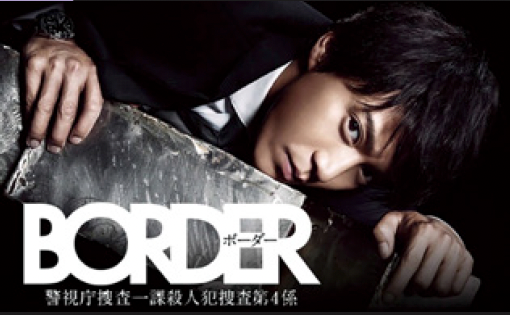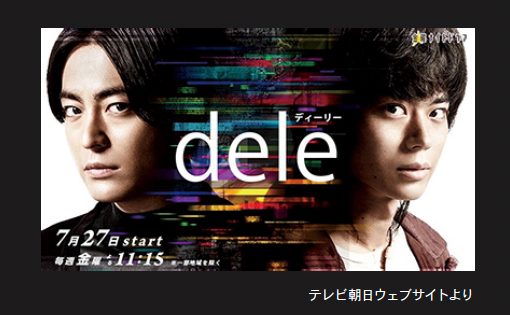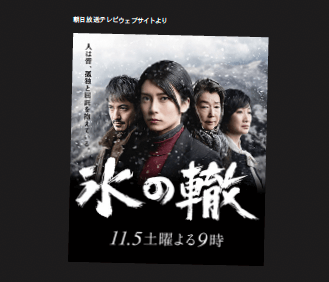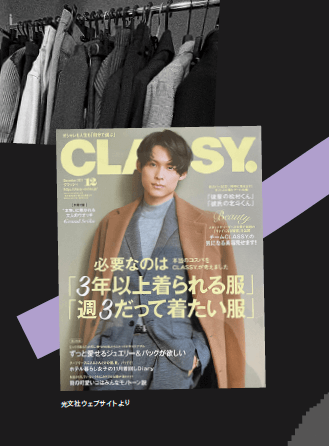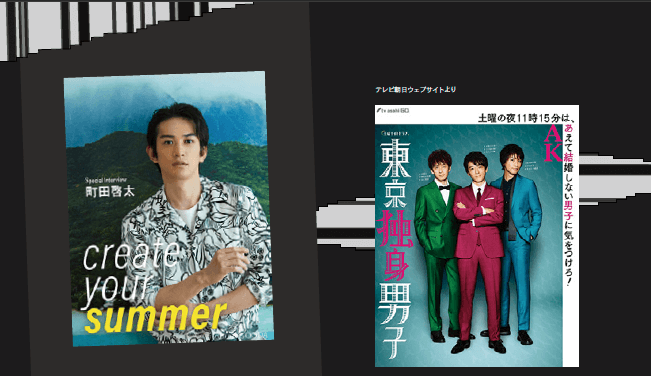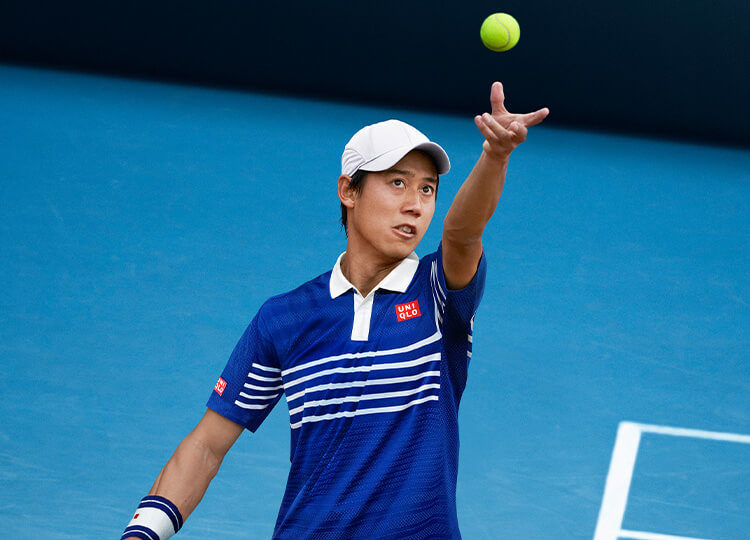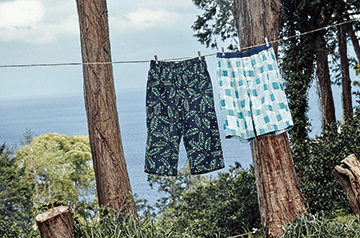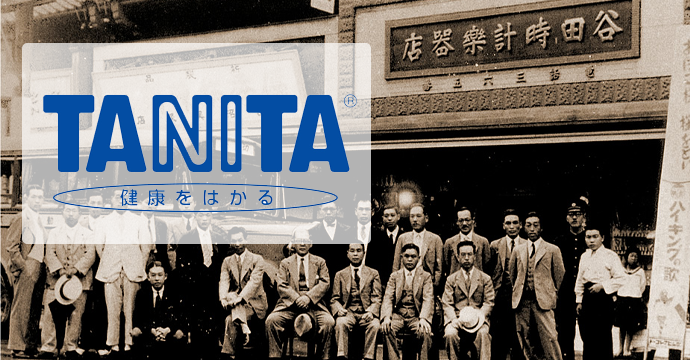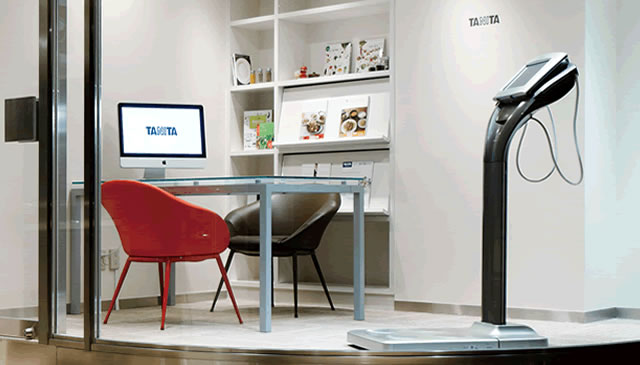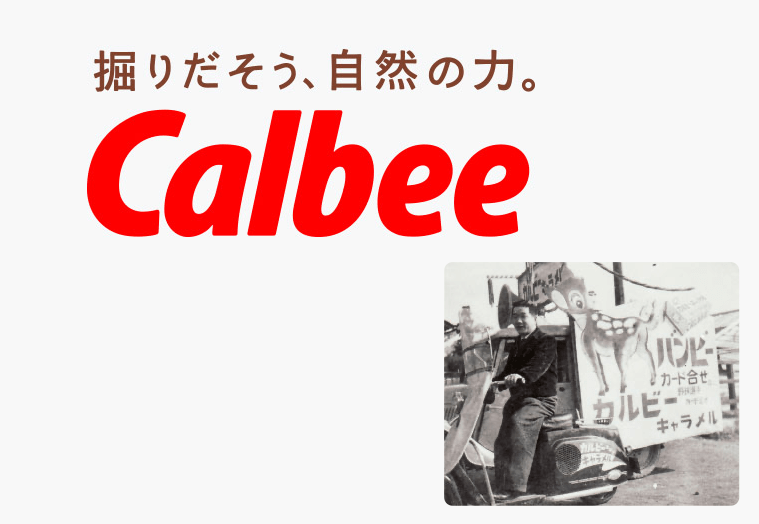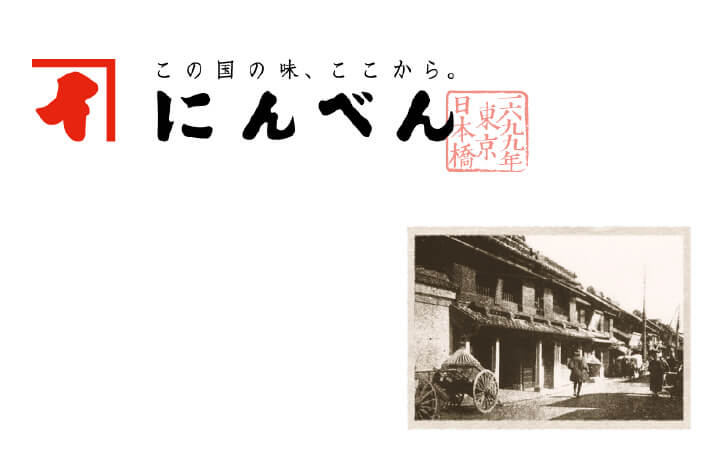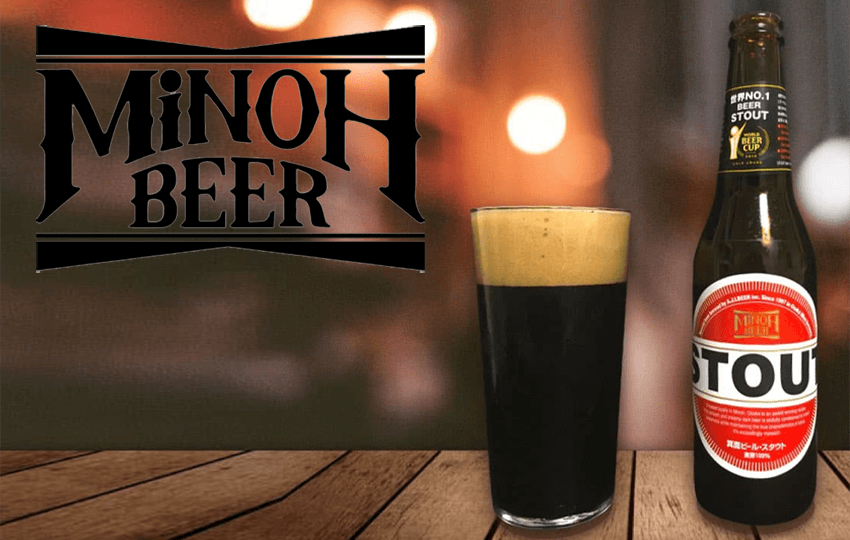-
You are the Protagonist
- Hiragana Times
- Jun 27, 2023
You are the Protagonist
あなたが主人公なんです
HONDA Hirohito / 本田博仁
HONDA Hirohito, who made his acting debut in his teens and later transitioned to becoming a stylist. He passionately pursues a unique expression through fashion based on his extraordinary devotion to clothing and a styling philosophy derived from his experience as an actor.
10代で俳優デビューし、その後スタイリストに転身した本田博仁さん。服に対する並々ならぬ情熱と、俳優ならではのスタイリング哲学をベースに、ファッションを通した唯一無二の表現を追求しています。
“The first drama I was in charge of costumes for was ‘BORDER: Metropolitan Police Department, Investigation Department, Homicide Investigation Section 4’ (TV Asahi, 2014). The protagonist is a dedicated detective whose life revolves around his work. He gets shot in an incident, leaving a bullet lodged in his head. This bullet gives him the ability to communicate with the dead and he proceeds to solve a series of murder cases—it’s the story.”
「初めて衣装を担当したドラマは『BORDER 警視庁捜査一課殺人犯捜査第4係』(テレビ朝日、2014年)という作品でした。主人公は仕事一筋の刑事です。彼はある事件で銃撃を受け、頭部に銃弾が残ったままになってしまいます。その銃弾が彼に死者と対話する能力を与え、次々起こる殺人事件を解決していく——というストーリーです」。

“I didn’t know anything about this world, but I developed an image of the main character from various words and created a suit from scratch.The suit was one size up and light gray before I took the bullet, but when I returned to work, I tightened the overall silhouette and lapel (collar) width. The ability to see and interact with the dead. And I wanted to express the tension in his life as he fulfills his mission.”
「右も左もわからない中で、僕は主人公に関するさまざまなワードからイメージを膨らませて、スーツ一式をいちから作りました。スーツは、銃弾を受ける前はワンサイズアップのライトグレーでしたが、職場復帰したときには、全体的なシルエットやラペル(襟)幅などをタイトにしました。死者が見え、対話できる能力。そしてその使命を全うして生きる彼の緊張感を表したかったのです」。
“As the story progresses, the bullet that remains in his brain starts to affect him, and he gradually becomes more unstable. To reflect that, we gradually changed the color of the suit from gray to black. We also made the tie narrower while reducing its brightness. In the final episode, where the tension of the story reaches its peak, I wanted to dress him in a suit that symbolizes his madness, like a mourning attire.”
「話が進むと、脳に残ったままの弾丸が悪さをして、彼は少しずつおかしくなっていきます。それに合わせる形で、スーツの色をグレーから徐々に黒に。ネクタイも色の明るさを落としながら細くしていきました。物語の緊張感がピークに達する最終回で、彼の狂気を象徴する喪服のようなスーツを着せたかったからです」。

Honda’s meticulous work, where he doesn’t cut corners even in the smallest details, was highly praised on the set. He is currently active in a wide range of media, including magazines, television, and advertising. In addition, he also offers a personal styling service called “MITAMENTAL” (a combination of “mitame,” which means appearance, and “mental”).
細部まで手を抜かない本田さんの仕事ぶりは、撮影現場で高く評価されました。彼は現在、雑誌やテレビ、広告など、幅広いメディアで活躍する一方で、「MITAMENTAL」(見た目とメンタル)という、個人向けのパーソナルスタイリングサービスも手がけています。

“I believe that clothing is the outermost expression of a person’s inner self. Even in the casual clothes we choose without much thought, there is inevitably a reflection of our subconscious. For instance, I recently styled a man who had a sleek, all-black ensemble with a sense of luxury, and even his shoes had studs, creating a polished and impeccable appearance.”
「服は、その人の一番外側の内面だと、僕は考えています。普段何気なく選ぶ服にも、その人の無意識が少なからず反映されています。たとえば、最近スタイリングしたある男性は、全身高級感のあるタイトな黒で、靴にも鋲[びょう]がついているような、隙がない見た目をしていました」。
“But he is a simple, pure man. He seemed to be struggling with his relationship with his wife. As we talked, I had an idea, and I took him to UNIQLO. I chose a beige nylon set-up. Inside, I had him wear a pale blue cut and sew.”
「でも、本人は素朴でピュアな人なんです。彼は、妻との関係性に悩んでいるようでした。話をする中で感じるものがあって、僕は彼を連れてユニクロに行きました。選んだのは、ベージュのナイロン素材のセットアップ。中には、淡いブルーのカットソーを着てもらいました」。

“He works as a financial planner and also manages an old traditional house. Because of his pure and gentle personality, I incorporated the softness of beige. Additionally, I brought in the color blue, which conveys an intellectual and sincere image, for the inner layer. I also chose a size one up for the clothes to give him some room to breathe.”
「彼はファイナンシャルプランナーで、古民家経営もしています。ピュアで優しい人柄だから、ベージュの柔らかさを入れました。また、理知的で誠実なイメージを持つブルーをインナーに持ってきました。服のサイズもワンサイズアップして、ゆとりを持たせるようにしました」。
At first, the man was perplexed, but eventually, he expressed the realization that by wearing streamlined garments without unnecessary elements, he may have been trying to exert control over himself.
男性は最初こそ戸惑っていましたが、やがて「無駄を省いたタイトなものを着ることで、自分自身をコントロールしようとしていたのかもしれない」という気づきを口にしたそうです。
“By giving him more room in his clothes, I wanted him to have more room in his heart. And I wanted him to have more room for his wife. Eventually, he reflected on the fact that he had been ignoring his wife’s feelings and spoke of his determination to let go of his conscious control, both over himself and over her.”
「服にゆとりを持たせることで、僕は彼の心に余白を作りたかったんです。そして、奥さんにも余裕を持って接するようになって欲しかった。最終的に彼は、妻の気持ちを無視していたことを反省し、自分に対しても彼女に対しても、意識的にコントロールを手放す決意を口にしました」。
Honda never imposes his own sense of beauty. Whether it’s a fictional character or a real person, he meticulously imagines and understands the lives of those he styles. Taking into account their past and present, he expresses a future through fashion that is suitable for that individual.
本田さんは、決して自身の美意識を押し付けません。架空のキャラクターでも実在の人物でも、スタイリングを行う相手の人生を丹念にイメージし、理解に努め、過去と現在を踏まえてその人にふさわしい未来をファッションで表現します。
“I went from being an actor to a stylist. At the time, I thought I had become a stylist because I wanted to make a living in a profession related to clothing, but looking back now, I realize that was a setback. But because of that experience, I want to tell people to accept and love themselves as they are.”
「僕は俳優からスタイリストになりました。当時は、服に関わる職で生きていきたいという思いからスタイリストに転身したつもりでいましたが、今振り返ると、あれは挫折だったのだと思います。でも、その経験があるからこそ、ありのままの自分を認めて愛することを伝えたい」。
“If you see yourself as the main character, the way you perceive things, the way you relate to others, and even the color of your life will change. In this day and age, there are many people who live their lives being swept away by their surroundings. I believe that the way you are in your own mind is everything.”
「自分を主人公として捉えれば、物事の受け取り方も人との関わり方も、さらには人生の彩りすら変わってきます。今の時代、周りに押し流されて生きている人は少なくありません。自分の心の在り方が全てだと思います」。
“I face my heart through my clothes. I believe that by getting to know yourself in this way, you can find your own personal comfort. Ultimately, I aim to create a style in which the person can be comfortable and be themselves, even in simple fashions like a white T-shirt and jeans. That is ultimately my proposal and what I want to do.”
「服を通して心と向き合う。そうして自分を知っていくことで、自分だけの心地良さを見つけられるのではないかと思います。究極的には、白いTシャツにジーンズのようなシンプルなファッションでも、その人が自分らしく、心地よくいられるスタイルを目指す。それが最終的には僕の提案であり、やりたい事です」。

Text: SAWAGUCHI Shota
文:澤口翔太
How To Purchase Magazines
Get your copy today and embrace the colorful world of Hirohito Honda’s creations.
Get your copy of the magazine now, available on Amazon, major bookstores, or through this link. Let the journey begin!Click here to get your copy是非、カラフルな誌面で、本田博人のファッションセンスを吸収しよう!本誌のお求めは、Amazon、大手書店もしくは、こちらのリンクからどうぞ。
-
[:ja][From August Issue 2015]
ユニクロ
プロテニスプレイヤーの錦織圭選手は今年の全仏オープンで初のベスト8入りを果たしました。錦織選手のテニスウエアに必ず入っていたのがカジュアルブランド「ユニクロ」のロゴマークです。2011年以来、錦織選手とスポンサー契約を結んでいるからです。
ユニクロというブランド名は「ユニーク・クロージング・ウエアハウス」を短く縮めたものです。親会社はファーストリテイリング(FR)です。もともとは1949年に山口県宇部市で設立された「メンズショップ小郡商事」でした。2015年2月末現在、FRグループ全体で世界中に2,872店舗を展開しています。その半分以上の1,558店舗がFRの中心的な会社であるユニクロです。
ユニクロの名前を一躍有名にしたのは1998年に発売したフリースでした。豊富なカラーと1,900円という値段で、評判となりました。2007年にはヒートテックが大成功を収めます。ヒートテックは「従来の綿素材に代わる、機能性の高いインナーが欲しい」という声に応えて開発されました。
これまでにないしなやかさや薄さは「まるで着ていないような気持ちよさ」として話題になりました。そのため、2007年の秋冬は生産が追いつかず、品切れ店が続出。夏に活躍するインナーでは、汗を吸ってもすぐに乾くエアリズムが注目されています。
ユニクロは高い品質と手ごろな価格の商品を世界に提供する製造小売業(SPA)として知られています。SPAとは商品の企画から生産、物流、販売まですべて自分の会社で行うビジネスモデルです。他社が真似できないユニクロ商品の数々はこの仕組みがあったからこそ生まれたものです。
ユニクロはファッションを通じて世界とつながることを目指しています。代表の柳井正さんは「世界中のあらゆる人々に、良い服を着る喜びや幸せ、満足を提供します」と会社の考えを説明。実際、ユニクロは素材の調達や生産、販売などで海外との関係を深めています。服作りだけでなくビジネスモデルとしてもユニークな会社といえるでしょう。
株式会社ユニクロ
文:伊藤公一[:en][From August Issue 2015]UNIQLO
For the first time in his career, pro tennis player NISHIKORI Kei made it to the quarterfinals of this year’s French Open. During the tournament he wore the logo of the casual fashion brand “Uniqlo” affixed to his tennis wear. This is because Uniqlo began sponsoring him in 2011.
The brand name “Uniqlo” is an abbreviation of “Unique Clothing Warehouse.” The parent company is Fast Retailing (FR). Formerly it was “Men’s Shop Ogoori Shoji” – a company founded in 1949 in Ube City, Yamaguchi Prefecture. As of the end of February 2015, the FR group had a total of 2,872 shops around the world. FR’s core business Uniqlo accounted for 1,558 of these stores; more than half.
Uniqlo was an overnight sensation when it started selling fleece jackets in 1998. It established its reputation because of the range of colors on offer and the low price of 1,900 yen. In 2007, Heattech became a huge success. Heattech was developed in answer to a demand to “replace cotton thermal underwear with garments made from another material.”
Heattech’s unparalleled snug fitting lightweight fabric that “feels as if you’re not wearing anything,” was much discussed. As a result, in the fall-winter season of 2007 (to 2008), production failed to keep up with demand and Heattech products sold out in one shop after the other. Now Airism – suitable wear for summer that absorbs sweat and is quick to dry – is in the spotlight.
Uniqlo is known as an SPA (specialty store retailer of private label apparel) and offers good quality reasonably priced products to the world. SPA is a business model in which everything is done in-house; from product planning, to production, to distribution, to sales. It’s thanks to the SPA system that Uniqlo was able to create so many unique products.
One of Uniqlo’s aims is to unite the world through fashion. President YANAI Tadashi explains the company’s philosophy: “We allow people the world over to attain the joy, happiness, and satisfaction that comes from wearing quality clothing.” In fact, Uniqlo is strengthening its ties with other countries through the procurement of materials, manufacturing, and sales. It’s fair to say that Uniqlo is an unusual company not only because it manufactures clothing, but also because of its business model.
Uniqlo Co., Ltd.
Text: ITO Koichi[:] -
Comfortable Traditional Japanese Suteteko
- Hiragana Times
- Jun 03, 2016
[:ja][2015年7月号掲載記事]
2011年頃から夏になると男女を問わずステテコを愛用する人が増えています。元々はズボンの下にはく男性用肌着として明治時代(19~20世紀)に誕生したものです。「綿クレープ」という細かくひだのよった生地が汗をよく吸いとるので特に暑い時期に着用されていました。その一方で「おじさんがはくもの」というイメージが強く、白い色も格好悪いと若い世代は徐々に着用しなくなってしまいました。
ステテコに再度光を当てたのは下着メーカー、株式会社アズの武村桂佑さんです。「ある日先輩からステテコを勧められたんです。なんで夏の暑いときに、ズボンの下にもう一枚はくのかと思いましたが、はいてみてびっくりしました。汗のべとつきが軽減されてさらさらな肌ざわりで過ごせたんです」と話します。
武村さんは同世代の友達にもステテコを勧めました。「みんなその快適さには驚いていましたが、やっぱりかっこ悪いなぁと言っていましたね」。しかし武村さんはステテコの持つ機能面に可能性を感じました。
また、武村さんがステテコを魅力的だと思ったのは、帰宅後にズボンを脱げばそのまま部屋着になる点です。これで色柄がついていたらアウターにもなると考えました。2008年に「ステテコ研究所」というサイトを立ち上げ、ウェブで斬新な色柄のステテコの販売を開始します。ステテコのイメージは快適な部屋着に変わり、女性の購入も増えました。
ステテコの人気を受け、他社からも様々なデザインや素材のステテコが販売されるようになりました。しかし、ステテコ本来の良さを一番感じることができるのは、日本の伝統素材である綿クレープを使用しているものだと武村さんは考えています。ステテコをベースにした女性用のヨガウエア、YOGATEKOも誕生しています。「ヨガウエアは外国製のものがほとんどです。そこで糸を紡ぐことからすべての製造を日本で行い、日本人の体型をカバーして動きやすく、足のラインがきれいに見えるウエアを作ることにしました」とヨガスタジオも主宰するYOGATEKO代表の藤絢子さんは言います。
藤さんはアメリカでの留学経験から日本人はもっと日本の良さを知るべきだと感じていました。そこで100%日本製の生地に日本の伝統文様を組み合わせました。ヨガパンツのほとんどが黒の中、華やかさでも注目されています。その一方で生地はオリンピック日本代表のウエアと同じ最新のものを使用。日本古来の良いものと日本の最新技術を融合した商品となりました。ステテコの固定概念が崩れた今、様々な分野で応用されています。文:市村雅代[:en][From July Issue 2015]
Since the summer of 2011, more and more people have been wearing “suteteko.” They first appeared in the Meiji era (19-20th centuries) and were originally used as underwear worn beneath men’s pants. They were made from “cotton crepe,” a crimped material that effectively absorbs sweat, and were regularly used during the hottest time of the year. However, since people thought of them as being “something old men wear,” white suteteko were perceived as being uncool and gradually fewer and fewer young people wore them.
TAKEMURA Keisuke of the underwear maker As Corporation is the person who hit upon the idea of reviving suteteko. “One day, a senior member of staff recommended that I try wearing suteteko. Although I had my doubts about wearing another item of clothing under my pants during the hot summer season, when I tried them on, I was surprised. It alleviated the sticky sensation produced by my sweat and felt smooth against my skin,” he says.
Takemura recommended suteteko to friends of his own generation. “Although everyone was surprised at how comfortable they were, they still felt dowdy in them.” In spite of that, Takemura felt that the functional aspect of them had potential.
In addition, Takemura was attracted by the fact that they could also double as lounge wear once pants are removed. By adding colors and patterns, he reasoned that they might even be worn as outerwear (as opposed to underwear). He established the “Steteco Research Laboratory” website in 2008 and started to sell suteteko on the web in daring colors and patterns. Suteteko was reinvented as comfortable lounge wear and purchases by women increased, too.
As suteteko grew more popular other companies also began to sell suteteko in a variety of different designs and materials. However, Takemura thinks that the best way to feel the utility of suteteko is to wear ones made of cotton crepe.Yogateko pants, modeled on suteteko, for women practicing yoga have also been created. “Most yoga wear is manufactured abroad. So, in order to make an item of clothing that would fit the Japanese figure and emphasize the beauty of a person’s legs, we decided that the entire production process down to spinning the yarn itself, would be done in Japan,” says TO Ayako, a representative of Yogateko, who also runs a yoga studio.
Since she studied abroad in the U.S., To felt that Japanese people ought to be better informed about the quality of items on offer in their own country. So, she combined a cloth entirely made-in-Japan with traditional Japanese patterns. Though most yoga pants are black, her gorgeous yoga pants have been attracting attention. In addition, it’s just been announced that the fabric she uses is the same as that worn by the Olympic athletes representing Japan. Suteteko have become an item that combines the positive aspects of Japanese tradition with the country’s latest technology. The fixed idea of suteteko has been altered and the clothing item has proved itself to be adaptable to a variety of different purposes.Text: ICHIMURA Masayo[:]
-
[:ja][2015年7月号掲載記事]
エプソン
家庭用プリンターで知られるセイコーエプソン株式会社(長野県諏訪市)は1985年に誕生しました。最初は有限会社大和工業と呼ばれていました。セイコーの腕時計の部品を製造する協力工場として1942年に生まれました。最初の工場は味噌蔵を改築したもので、従業員数は9名でした。
社名にもなっているエプソン(EPSON)というブランドは、1969年に発売した小型軽量デジタルプリンター「EP(Electric Printer)-101」にちなんで名付けられました。この製品は1964年の東京オリンピックで使われた「プリンティングタイマー」という装置が発展したものです。この大会で、セイコーグループは公式に記録をとる仕事を任されていました。
EP-101はプリンターの重量を既存の4分の1にまで一気に小型軽量化した画期的なものでした。電卓の印字装置として採用され、一時期、電卓の世界シェア90%を超えるほど大ヒットしました。EP-101の成功によって、セイコーエプソンはプリンターメーカーの道を歩み始めます。
ブランドのEPSONには「この製品(EP)の子ども(Son)のような製品を世に送り出したい」という願いを込めています。今年で40周年を迎えます。現在は会社のルーツである腕時計やプリンターばかりでなく、プロジェクターやセンサー機器、半導体、水晶振動子、産業用ロボット・装置など、さまざまな「子どもたち」が育っています。
セイコーエプソンの特徴は腕時計やプリンターなどで長年培ってきた「省・小・精の技術」です。また、新しいものに果敢に取り組むという「創造と挑戦」の社風があり、これらから世界初の技術や製品がたくさん生まれています。
例えば1969年には、世界初のクオーツ腕時計「セイコー クオーツアストロン35SQ」を商品化。当時の機械式腕時計は進んだり遅れたりする誤差が一日20秒ほどありました。この製品はその差をわずか0.2秒の精度まで高めたのです。この製品で時計の世界が大きく変わりました。
1994年には、カラーインクジェットプリンターの初代機「MJ-700V2C」を発売。10万円を切る価格と写真並みの高画質が評判となりました。今日、インクジェットプリンターの活用範囲は広告用ポスター、商品ラベル、布地への印刷、電子部品製造といった商業・産業分野にまで広がっています。
セイコーエプソン株式会社
文:伊藤公一[:en][From July Issue 2015]EPSON
Known for its home-use printers, Seiko Epson Corp. (Suwa City, Nagano Prefecture) was founded in 1985. In the beginning, the company was called Daiwa Kogyo, Ltd. The latter was founded in 1942 as a factory to manufacture components for Seiko wristwatches. This first factory was a renovated miso storehouse and had nine employees.The Epson name came about when the small digital “EP (Electric Printer)-101” went on sale in 1969. This product evolved from a device used in the 1964 Tokyo Olympics called a “printing timer.” The Seiko group was the official timekeeper for those games.
The EP-101 was a breakthrough in that it was only a quarter of the size and weight of other printers on the market. It was used as a printer for calculators and was so successful that at one time had more than 90% of the total market share for calculators. With the success of the EP-101, Seiko Epson began life as a manufacturer of printing devices.The Epson brand was established with a wish to “bring the offspring (sons) of this product (the EP) into the world.” This year is the brand’s 40th anniversary. In addition to the printers that got the company started, all kinds of offspring have been reared, and now this includes projectors, sensors, semiconductors, quartz resonators, industrial robots, and other devices.
The characteristic hallmark of Seiko Epson is its “energy-saving, compact, and precise technology,” which is the company’s technological know-how acquired through the development of wristwatches and printing devices. The company’s culture of “creation and risk-taking” allows it to courageously pioneer new ideas and this has led to the development of numerous technologies and products that were the world’s firsts.
For example, the world’s first quartz wristwatch, “Seiko Quartz Astron 35SQ,” was sold in 1969. Mechanical wristwatches in those days could lose or gain up to 20 seconds per day. This product was more precise and reduced the difference to just 0.2 seconds. This product had a huge impact on the global watch industry.
In 1994, the first color inkjet printer, the “MJ-700V2C,” was launched on the market. It stood out for its less than 100,000 yen price tag and photographic image quality. Today, the applications for inkjet printers have spread to commercial and industrial areas, among other things, for ad posters, product labels, textile printing, and the manufacture of electronic components.
Seiko Epson Corp.
Text: ITO Koichi[:] -
[From June Issue 2015]
Tanita
In Japan, every household has a bathroom scale (health meter), and most nowadays keep track of your body composition. Besides your weight, these scales can also measure, body fat percentage, muscle mass, metabolic rate, visceral fat, and more. The history of body composition monitors dates back to the days of bathroom scales and body fat meters. After putting bathroom scales on the market, Tanita Corporation (Itabashi City, Tokyo Prefecture) launched the world’s first scale to measure body fat percentage by simply standing on it.The compan
y was founded in 1944. In those days, rather than producing health monitoring devices, it manufactured metallic products, such as cigarette cases. Before long the company was producing gadgets that were ahead of their time, such as electric kettles, and electric lighters. Then the scales department was founded, and Tanita began selling measuring devices.
Since Tanita was established, the company has capitalized on its technological expertise to launch technology, products, and services that were unprecedented, either in Japan or worldwide. These products included sleep meters to measure quality of sleep and electronic meters to measure urine sugar levels – which are closely related to blood glucose levels. These were all created out of the company’s desire to “promote people’s health by monitoring it.”
The Tanita name has become better known since the publication in 2010 of “The Staff Cafeteria of Tanita, Body Fat Scale Maker” (published by Yamato Shobo). The book contains recipes for meals served at the head office’s staff cafeteria. Comprising of a soup with three side dishes, these set meals contain approximately 500 kilo calories and three grams of salt. Positive feedback from readers can be summarized as follows: “After sticking with this diet, I have a healthier body.”
In 2012, the “Marunouchi Tanita Cafeteria” opened its doors in the Marunouchi business district in Tokyo. The restaurant was created because so many readers had commented that they’d like to eat at the staff cafeteria. A professional spec body composition monitor is installed in the restaurant and a registered dietitian gives health and diet advice based on the measurement results in a consultation room.
Two kinds of meals are available – daily specials or meals that are served according to the day of the week – and just like the staff cafeteria, it’s self-service. The recommended serving of rice is 100 grams. By the effective use of dashi stock and spices and by not over boiling the vegetables, care is taken to ensure that the low calorie count and low salt content does not adversely impact on the taste of the meal.
Fureai Hiroba Plaza within the grounds of Tanita’s head office is open to the public. It has a 150-meter walking and running track and a “Health Trail” with stones of difference shapes that stimulate pressure points on the sole. The space is also used for the benefit of the local community.
Tanita Corporation
Text: ITO Koichi[2015年6月号掲載記事]
タニタ
日本ではどの家庭にも体重計(ヘルスメーター)がありますが、今は体組成計が主流です。体重以外に体脂肪率や筋肉量、基礎代謝量や内臓脂肪レベルなどをはかることができます。体組成計の歴史は体重計、体脂肪計にさかのぼります。株式会社タニタ(東京都板橋区)は体重計を発売後、世界初の、乗るだけではかれる体脂肪計を発売しました。
同社の設立は1944年。当時は健康計測機器ではなく、シガレット・ケースなどの金属加工メーカーでした。やがて電気ポットや電子ライターなど、時代を先取りするさまざまな商品を次々に手掛けました。さらに、はかり事業部を設置し、はかる商品を発売してきました。
タニタは設立以来、独自の技術力を高め、日本初・世界初の技術や商品、サービスなどを世の中に送り続けてきました。たとえば、睡眠の状態をはかる睡眠計、血糖値と関係の深い尿糖値をはかる電子尿糖計があります。どれも「はかる」を通して人々の健康づくりに貢献するという同社の願いから生まれたものばかりです。
タニタの名前がより一層知られるようになったのは、2010年に発行された本「体脂肪計タニタの社員食堂」(大和書房発行)でした。これは本社の社員食堂のメニューをまとめたレシピ本です。どれも一汁三菜の定食スタイルで500キロカロリー前後、塩分3グラム前後。「続けて食べることで健康的な体に変わった」などの声が寄せられました。
2012年にはビジネス街である東京・丸の内に「丸の内タニタ食堂」がオープンしました。多くの読者から、社員食堂で食べてみたいという声が寄せられたからです。ここでは、プロフェッショナル仕様の体組成計を設置し、管理栄養士が計測結果と健康と食事に関するアドバイスをするカウンセリングルームがあります。
ここで出されるメニューは日替わりと週替わりの2種類で、社員食堂と同じセルフサービス式。ごはんは100グラムをすすめています。だしやスパイスをきかせたり野菜をゆで過ぎないようにしたりすることで、カロリーや塩分が低くてもおいしさを損なわない工夫をしています。
本社内の敷地にはふれあい広場があり、一般に開放しています。ウオーキングやジョギングが可能な1周約150メートルのコースや、形の異なる石を敷き詰め足のつぼを刺激する「健康小径」などが設けてあります。地域貢献の場としても利用されています。
株式会社タニタ
文:伊藤公一 -
[From May Issue 2015]
Calbee
In Japan, fried carbohydrate snacks of corn, potatoes, or beans, are called “snack gashi.” CALBEE, Inc. products account for a 50% share of this market. The word Calbee is neither Japanese nor English. It conveys the sentiments of the company’s founder who was thinking of the nation’s good health when he coined the word.
Founded in Hiroshima Prefecture in 1949, the company was formerly known as Matsuo Food Industries. MATSUO Takashi, then president, was concerned about malnutrition among post-war Japanese people and aimed to create products that would improve the health of consumers. The company name was changed in 1955 to Calbee Foods and Confectionery Co., Ltd.; a name that combines calcium, “cal,” and vitamin B1, “bee.”
In that same year, the company succeeded in making arare (roasted mochi pieces) from wheat rather than rice – the main ingredient up until then – and marketed it as “Kappa Arare.” In 1964, “Kappa Ebisen,” a snack made from mixing ground raw shrimp into wheat dough, was developed. It became a big hit and the jingle “I can’t stop, I won’t stop, Calbee, Kappa Ebisen” made the Calbee name popular throughout the nation.
The year 1972 saw the launch of the potato based snack, “Sapporo Potato.” The company’s name was shortened to CALBEE, Inc. when its head office moved from Hiroshima to Tokyo in 1973. In 1975, “Potato Chips” was launched, a snack which later became one of the company’s core products. In 1985, the material used in the packaging of all products was switched from vinyl to aluminum film. This prevented any loss of flavor caused by oxidation.
Calbee takes great care in its control of raw ingredients. For example, shrimps – one of the ingredients in Kappa Ebisen – are carefully selected, flash-frozen while fresh to a temperature lower than -30 °C and transported to the factory. In the factory, the entire shrimp, including shell, is ground up and used. Red particles on the exterior of Kappa Ebisen are proof that the whole of the shrimp is used.
Approximately 330 thousand tons of potatoes are procured yearly to make potato chips and other products. From breeding potato varieties to cultivation, to storage, to transportation, to sales, an agreement has been made with other manufacturers to work in cooperation with each other to ensure the entire process goes smoothly. Currently more than 1,000 producers in the Hokkaido area alone have entered into this contract. The so-called field men of Calbee Potato, Inc. (an affiliated company in charge of potato procurement, storage, etc.) support the producers with surveys, advice and an exchange of information concerning cultivation.
Calbee products are consumed in ten other countries. For example, “Harvest Snaps” made from beans are popular in the US, Canada, and the UK. In Singapore, “Hot & Spicy” potato chips are a hit and in Thailand, “Kappa Ebisen Original” – developed locally for the Thai palate – is selling well.
The total number of products produced by Calbee in Japan in the financial year of 2013 was 1.8 billion. The company organizes “Calbee Snack Schools” to teach children how to have a healthy enjoyable diet. In 2013 62,251 children in 787 schools across the nation attended the course. This project not only increases the number of Calbee fans, but is also the company’s way of contributing to regional development.
CALBEE, Inc.
Text: ITO Koichi[2015年5月号掲載記事]カルビー
日本では、トウモロコシやイモ、豆などの炭水化物を使って揚げた菓子類を「スナック菓子」と呼んでいます。この分野で国内の半分を超えるシェアを占めているのがカルビー株式会社の商品です。カルビーは日本語でも英語でもありません。国民の健康を願う創業者の気持ちが込められた造語です。
同社の前身は1949年に広島県で設立された松尾糧食工業株式会社です。当時の社長だった松尾孝さんは戦後の日本人が栄養不足に陥っていることに胸を痛め、健康に役立つ商品づくりを目指しました。1955年、大事な栄養素であるカルシウムの「カル」とビタミンB1の「ビー」を組み合わせたカルビー製菓株式会社に社名を改めました。
同じ年に、本来は米でつくるあられを小麦でつくることに成功し、「かっぱあられ」として売り出しました。1964年には生えびを小麦生地に練りこんだ「かっぱえびせん」を開発。これは「やめられない、とまらない、カルビー、かっぱえびせん」というCMソングと共に大ヒットし、カルビーの名を全国に広めました。
1972年にはじゃがいもを原料にした「サッポロポテト」を発売。1973年に本社を広島から東京へ移したのを機に現在の社名に変更しました。1975年には同社の代表商品となる「ポテトチップス」を売り出しました。1985年からは全製品の袋をビニール製からアルミ蒸着フィルムに変えました。これによって酸化で風味が落ちることがなくなりました。
カルビーは原料の管理にとても気をつかっています。例えば、かっぱえびせんの原料となる小えびは厳選され、新鮮なうちにマイナス30度以下に急速冷凍され、工場に運ばれます。工場では小えびを殻ごとミンチにして頭からしっぽまで丸ごと使います。かっぱえびせんの表面に赤いつぶつぶがあるのは、小えびをすべて使っている証拠です。
ポテトチップスなどに使われるじゃがいもの調達量は年間約33万トン。契約生産者と協力し、品種の開発から栽培、貯蔵、輸送、販売までを一貫して管理する仕組みを整えています。現在は北海道だけで1,000人以上の生産者と契約しています。フィールドマンと呼ばれるカルビーポテト株式会社(じゃがいもの調達、貯蔵などを担うグループ会社)のスタッフが栽培に関する調査や助言、情報交換で生産者を支援します。
カルビーの製品は海外10ヵ国でも食べられています。例えば、アメリカ、カナダ、イギリスでは、豆を原料に使った「ハーベストスナップス」が人気です。シンガポールではポテトチップスの「ホット&スパイシー」が、タイではタイ人の好みにあわせて現地で開発した「かっぱえびせんオリジナル」が売れています。
2013年度のすべての商品の国内生産量は約18億袋。同社は子どもたちに健康的で楽しい食生活の仕方を伝える「カルビースナックスクール」を開催。同年度は全国787校の62,251人が受講しました。この企画はカルビーファンを増やすだけでなく、地域貢献策としても役立てられています。
カルビー株式会社
文:伊藤公一 -
[From April Issue 2015]
Nagatanien
Tea in its many forms is deeply connected to Japanese history and culture. One of the most popular teas consumed today is sencha; a green tea invented by NAGATANI Soshichiro – founder of what was to become Nagatanien Co., Ltd. – in the Edo era (17-19th centuries). That is to say that originally the Nagatani family ran a tea production business. Sencha was eventually exported to Western countries and, along with raw silk thread, became one of Japan’s major exports.
In 1952, NAGATANI Yoshio, the tenth Nagatani to run the family business, developed “Ochazuke Nori” with his father Takezo so that people could easily consume delicious ochazuke (a dish of rice and tea) at home. At that time ochazuke nori was powdered shredded seaweed, seasoning, and arare (rice crackers) mixed together by hand. As neither aluminum foil nor polyethylene was available in those days, to prevent humidity from spoiling the seaweed, 100 bags of double the usual thickness were stored in a bottle that had a layer of lime placed inside its base.
Sales of Ochazuke Nori steadily increased and it eventually became a hit product nationwide. In 1953, a year after the product was launched, Yoshio established Nagatanien Honpo Co., Ltd. He subsequently created a series of long selling products such as “Matsutake no Aji Osuimono,” “Sake Chazuke,” “Asage” and “Sushi Taro,” all of which can still be found in stores today.
In 1979, a man, who was in charge of the production department, was chosen to be the company’s first “idle employee.” Yoshio told him, “You don’t have to come to work. You can spend as much as you want. You don’t need to report back. Eat whatever you want and come up with something in two years.” Having created a series of hit products, Yoshio knew that “good ideas don’t only surface when you’re sitting at a desk.”
The man from the production department followed his orders and, searching for ideas for new products, traveled extensively sampling food both in and outside of Japan. Two years later, he ended up launching “Mabo Harusame,” a combination of “Chinese soup” and “harusame” (thin noodles). Mabo Harusame, the world’s first instant Chinese food, was a big hit. Along with this product, the dish itself became popular nationwide.
In 2003, the A-Label range for people with food allergies was created. During the developmental stage, some employees voiced concerns that it would be hard to maintain quality without eggs, milk and flour, but these difficulties were overcome with the launch of a curry in a sealed plastic pouch and furikake (dried seasoning for rice). In response to an unexpected influx of positive comments from mothers – such as “I’ve been waiting for a product like this” and “Please create more products like this in the future” – more resources are being allocated to product development and the marketing of this range.
At the time of writing, the “What are you going to put on Japan?” project, to get consumers to suggest new ways of eating Ochazuke Nori, is underway. Ochazuke, made of typical ingredients used in Japanese cuisine such as rice, tea and seaweed, is likened to Japan itself. “Ochazuke cars” are now traveling around Japan showcasing recipes that incorporate local delicacies.
Nagatanien Co., Ltd.
Text: ITO Koichi[2015年4月号掲載記事]
永谷園
お茶は日本の歴史と文化に関係の深い飲み物で、たくさんの種類があります。このうち、今日でも広く飲まれている煎茶は株式会社永谷園の創始者となる永谷宗七郎さんが江戸時代(17~19世紀)に発明しました。つまり、永谷家はもともと製茶業を営んでいたのです。やがて煎茶は欧米各国に輸出されるようになり、生糸と並んで日本を代表する商品となりました。
10代目の永谷嘉男さんは1952年、家庭でおいしいお茶漬けが簡単に食べられるようにと父の武蔵さんと一緒に「お茶づけ海苔」を開発しました。お茶づけ海苔は刻み海苔、調味粉、あられを手作業で合わせたものでした。アルミ箔もポリエチレンもない時代なので、海苔が湿気ないよう袋を二重にし、底に石灰を敷いたびんに100袋ずつ詰めました。
お茶づけ海苔は順調に売り上げを伸ばし、全国的なヒット商品に成長。嘉男さんは発売翌年の1953年に株式会社永谷園本舗を設立しました。嘉男さんはその後も「松茸の味お吸いもの」「さけ茶づけ」「あさげ」「すし太郎」など、今日でも店頭に並ぶロングセラー商品を続々と生み出しました。
1979年、ある開発担当者は同社初の「ぶらぶら社員」に選ばれます。嘉男さんは「出社は自由。経費も無制限。報告も不要。食べたいものを食べて、2年後に結果を出
せ」と命じました。ヒット商品を次々に作った嘉男さんは「良いアイディアが浮かぶのは、机に向かっている時だけではない」と考えていたからです。
開発担当者は命令に従い、国内外をくまなく食べ歩いて新商品のアイディアを探し続けました。2年後、「中華スープ」と「春雨」を組み合わせた「麻婆春雨」を送り出すことになります。麻婆春雨はそれまで世界のどこにもなかった中華おかずの素として大ヒット。商品と共に、この料理自体も全国に広まっていきました。
2003年には食物アレルギーに配慮したA-Labelシリーズが生まれました。開発中には、卵や乳、小麦を使わずに同じ品質を保つのは困難という声もありましたが、苦労の末にレトルトカレーとふりかけを販売。「こういう商品を待っていました」「これからも増やしてください」という母親の声が予想以上に多いため、この分野の商品開発、普及活動に力を注いでいます。
現在はお茶づけの新しい食べ方を提案するプロジェクト「日本の上に何のせる?」を行っています。米、お茶、海苔など、日本を代表する食材でできているお茶づけを、日本に例えました。「お茶づけカー」が日本各地をまわり、それぞれの名産品を取り入れたレシピを紹介しています。
株式会社永谷園
文:伊藤公一 -
[:ja][2015年3月号掲載記事]
株式会社にんべん
味噌汁をはじめとする和食の味のベースとなっているのが「だし」です。味を付けるのではなく、味に深みを持たせるために使われます。魚を干して発酵させたもの、海藻を干したものなど種類は様々です。一般的に使われているだしの一つが、煮たかつおを乾燥し発酵させたかつお節です。株式会社にんべんはそのかつお節を1699年から販売しています。
かつて日本の家庭では、料理をする際にだしを取ることから始めました。お湯にかつお節などの素材を入れ、うまみが出たらお湯から取り出し、だし汁(だしともいう)を作るのです。近年では手間を省くため、お湯に溶かして使う粉末のだしやだし入りの味噌が発売されています。
にんべんは、かつお節そのものより関連商品を多く販売しています。「各商品のベースになるものはかつお節ですが、現在は「つゆの素」などの液体調味料が全体の6割を占めています」と経営企画部の遠藤治彦さんは言います。
そうした世の流れの中で、にんべんは2010年、COREDO室町1の日本橋本店(東京)に「日本橋だし場」をオープンしました。削りたてのかつお節で取っただしの香りとうまみを体験してもらうことが狙いでした。「オープン前は、テイクアウトできる汁物と削りたてのかつお節を振りかけた『かつぶしめし』のランチメニューをメインと考えていました」と遠藤さんは話します。
ところが実際には一番人気の商品はかつお節の香りとうまみをシンプルに味わえる「かつお節だし」でした。多いときで一日1,800杯売れたこともあるほどです。今年1月には累計で55万杯に達しました。このような人気を受け、昨年は羽田空港国際線ターミナルに2号店もオープンしています。和食がユネスコの無形文化遺産に登録されたこともあり、日本橋だし場への注目度は以前よりもあがっていると遠藤さんは感じています。
遠藤さんは「かつお節だしを飲むと気分がリラックスできるようです」と話します。だしそのものを飲むというのは一般的ではありませんが「胃にもやさしいのでコーヒーなどの代わりにもおすすめです」と言います。日本橋だし場には、砂糖とミルクが並ぶコーヒースタンドのように味付け用に塩としょうゆが並んでいます。
これまでかつお節といえば和食だと多くの人が思っていました。しかし「洋風、中華にも使えます」と遠藤さんは言います。また、かつお節は高たんぱくで体にやさしい食品としても注目されています。食生活の変化に伴って、かつお節を使う機会は広がるようです。
株式会社にんべん
文:市村雅代[:en][From March Issue 2015]Ninben Co., Ltd.
Used in dishes such as miso soup, “dashi” stock is a basic ingredient in Japanese cuisine. Dashi is not used for its flavor, but is added to enhance other flavors. There are many kinds of dashi stock including dried fermented fish and dried seaweed. The most commonly used ingredient is katsuobushi, which is made from boiled bonito which is dried and fermented. Ninben Co., Ltd. has been selling katsuobushi since 1699.
In the past, home cooking in Japan used to begin with making dashi. To make a dashi stock, katsuobushi or some other ingredient was placed in hot water and removed once the umami (savory) flavor had been extracted. To save time, in recent years dashi powder and miso that contains dashi has been put on the market.
Rather than simply selling katsuobushi on its own, Ninben is selling more products containing katsuobushi. “All our products contain katsuobashi as a basic ingredient, but liquid seasoning such as “Tsuyu-no-Moto” accounts for 60% of our sales these days,” says ENDO Haruhiko of the corporate planning department.
In line with this trend, in 2010 Ninben opened the “Nihonbashi Dashi Bar” inside its Nihonbashi flagship store at COREDO Muromachi 1 (Tokyo). The aim was to allow customers to experience for themselves the umami flavor of dashi extracted from freshly shaved katsuobushi. “Before opening, we thought take-out soups and “katsubushi rice” – a lunch dish topped with fresh katsuobushi shavings – would be our main best-sellers,” Endo says.
But unexpectedly, the most popular product turned out to be the simple “katsuobushi dashi.” The most sold in one day was 1,800 servings. By January this year the total servings reached 550,000. Given this success, a second store was opened last year at the International Terminal of Haneda Airport. Endo feels that Nihonbashi Dashibar is attracting more attention now Japanese cuisine is on UNESCO’s intangible cultural heritage list.
Endo says “katsuobushi dashi has a relaxing effect on those who drink it.” Although it’s not common to drink dashi on its own, “it’s so gentle on the stomach that we recommend it as a substitute for drinks like coffee.” At the Nihonbashi Dashi Bar, like sugar and milk in a coffee stand, salt and soy sauce are available for seasoning.
Until recently, many people thought katsuobushi was exclusively for Japanese food. Yet, Endo says “it can also be used in Western and Chinese dishes.” Katsuobushi is now making waves as an ingredient that is high in protein and gentle on the body. As our dietary habits evolve, it’s possible there will be more opportunities to use katsuobushi in the future.
Ninben Co., Ltd.
Text: ICHIMURA Masayo[:] -
[From March Issue 2015]
Nikon
Founded in 1917, Nikon Corporation (Minato City, Tokyo Prefecture) is a world-class manufacturer of optical devices. It was founded to manufacture optical products which could not be imported due to the ramifications of World War I and an investment by IWASAKI Koyata, President of Mitsubishi Limited Partnership made it possible to merge three companies that respectively made gauges, glass, and lenses. When it was established, the company name was Nippon Kogaku K.K.
Nikon was originally the name of a small camera Nippon Kogaku K.K. launched in 1948. In the planning stages the camera had initially been called the Nikolette, a name derived from Nikko, an abbreviation of Nippon Kogaku. The idea was revisited, however, because many in the company felt that “Nikolette would be too weak a name for a future core product.” Then, to make the name sound stronger, ‘n’ was attached to the end of Nikko and thus Nikon was used.
There is an anecdote concerning the company name. At a ceremony to mark the twinning of Tokyo and Paris, then president FUKUOKA Shigetada introduced himself to the mayor of Paris as “Fukuoka from Nippon Kogaku K.K.,” but the mayor looked baffled. When his secretary informed him that the company made Nikon cameras the mayor answered in a friendly tone, “I know Nikon very well.”
The product name had become more famous than the company name. The company name was changed to Nikon in 1988 at the suggestion of insiders who believed Nikon was already an internationally well-known brand with a reputation for reliability.
Nikon cameras and “NIKKOR” interchangeable lenses are so reliable that they are used by the majority of media companies in and outside Japan. When the Korean War broke out in 1950, photojournalist David Douglas DUNCAN took pictures with NIKKOR lenses. Those pictures were featured in the American photo magazine “Life.” The sharpness of these pictures created quite a stir in the magazine’s editorial department in New York. At the same time the New York Times wrote about Nikon’s high quality.
Nikon products are also used in space. Designed to NASA specifications, in 1971, the “Nikon Photomic FTN” was used on the Apollo 15 mission. Since then, Nikon has long been supplying cameras and interchangeable lenses to NASA. WAKATA Koichi, the first Japanese commander of the International Space Station (ISS) who returned to Earth in May 2014, used a “D4” to take pictures of space and the Earth.
Today, with an emphasis on precision equipment, imaging and instruments, the company has diversified. Its focus is not only on cameras, but also on the development of industrial products such as semiconductor/FPD (flat panel display) lithography systems, microscopes, and measuring instruments. Considered the most precise machines in history, semiconductor lithography systems make IC (integrated circuits) which are an integral part in all electronic devices. Nikon is beginning to apply its core technologies – namely optics and precision engineering – in the fields of health and medicine.
Nikon Corporation
Text: ITO Koichi[2015年3月号掲載記事]ニコン
株式会社ニコン(東京都港区)は1917年に設立された、世界を代表する光学機器メーカーです。第一次世界大戦の影響で輸入できなくなった光学製品を作るため、三菱合資会社社長、岩崎小彌太さんの出資で、計器、ガラス、レンズ関係の3社が統合して生まれました。設立時の社名は日本光学工業株式会社です。
ニコンという名前はもともと、日本光学工業が1948年に発売した小型カメラのブランド名でした。当初は日本光学の略称である日光(ニッコー)にちなんだニコレットという名前を付ける準備をしていました。しかし「将来の主力製品となるべき商品の名前としては弱い」という意見が社内でたくさん出たため、考え直すことになりました。そして、ニッコーの後にnを付けて言葉の響きを強くしたニコンが採用されることになりました。
会社名についてのエピソードがあります。東京とパリが姉妹都市になったときの式典で、当時の社長だった福岡成忠さんが「日本光学工業の福岡です」とパリ市長に挨拶したとき、市長は首をかしげました。市長の秘書がニコンを作っている会社であることを教えると、「ニコンならよく知っている」と親しげに話しかけてきたといいます。
社名よりも製品名のほうが有名になっていたのです。すでに国際的に通用し、信頼度も高いニコンの方が良いとの社内の意見により、1988年に社名をニコンに変更しました。
ニコンのカメラと交換レンズ「ニッコール」は信頼性が高く、国内外の報道機関のほとんどが採用しています。1950年に始まった朝鮮戦争のとき、写真家のデビッド・ダグラス・ダンカンがニッコールで撮影。その写真がアメリカの写真誌「ライフ」に掲載されました。ニューヨークの編集部では、どうしたらこんなにシャープな写真が取れるのだろうと大騒ぎになりました。性能の高さは、当時のニューヨーク・タイムズで報じられました。
ニコン製品は宇宙でも活躍しています。1971年にはアポロ15号でNASA仕様の「Nikon Photomic FTN」が使われました。これを皮切りに、ニコンは長年にわたってNASAにカメラと交換レンズを納入しています。日本人初の宇宙ステーション(ISS)船長を務め、2014年5月に地球に帰還した若田光一さんが、「D4」を使って宇宙空間や地球を撮影しました。
現在は精機事業と映像事業、インストルメンツ事業を中心として事業領域を広げています。カメラばかりでなく、半導体・FPD(フラットパネルディスプレイ)露光装置や顕微鏡、測定機など、産業分野の製品開発も重視しています。半導体露光装置は史上最も精密な機械と呼ばれ、身の回りにある電子機器に欠かせないIC(集積回路)を製造します。また、ニコンの核である光利用技術や精密技術を健康・医療分野に生かし始めています。
株式会社ニコン
文:伊藤公一 -
[From February Issue 2015]
President of Minoh Brewery
OSHITA Kaori
Craft beer is attracting attention these days. The popular “Minoh Beer” was created in the pastoral city of Minoh, Osaka Prefecture. OSHITA Kaori is both company president and factory manager. “My mother and two younger sisters work with me. When I first helped out with the business, it felt like a part-time job as I was a student,” says Kaori. She was later drawn into the fun of beer making.
Minoh Brewery has won many major awards in Japan. Since 2009, it’s won awards six years in a row at international beer competitions. The success of this family run craft beer has been much discussed. Its international reputation has made this beer popular nationwide. “I could never have predicted that our Minoh Beer Stout would be chosen in the UK, the land of stout. It was quite a surprise. I was glad our longtime fans were also delighted,” says Kaori.
As the factory is small in size, it can only produce limited quantities, but great care is taken to brew the beer. Although beer production processes usually include filtration and heat treatment, Minoh Brewery does without them. “Bottling is done without filtering out the yeast. Freshness is the key, so we ship it cold and our customers also keep and sell it cold. Our beer is rich in vitamins and minerals, so it’s also beneficial for health and beauty,” says Kaori.
Minoh Brewery was founded in 1996 by Kaori’s father, OSHITA Masaji. It’s been 18 years since the company was established, and its owners have been through the ups and downs of the craft beer boom even to the extent that they had considered shutting down the business. Prominent in Japan’s craft beer industry, he sadly passed away two years ago.
Last year, a special beer to pay homage to Masaji’s memory was put on the market at the suggestion of a friend in the industry. This year, to mark the third anniversary of Masaji’s death, several companies produced beers bearing an image of him on them. Minoh Brewery itself released GOD FATHER3. “My father was a lively active man, everyone loved him. I’m glad he’s still remembered through beer.”
On the first floor of the factory cum head offices, there’s a tasting bar that can be visited for a fee. Neighbors can casually pop in here while taking a walk. Sometimes foreign tourists who have heard about the reputation of Minoh Beer also pay a visit. “We’ve been running this place since the company was established, because we’d like people to drink the beer as soon as it’s been made. Apart from our fixed holidays, we are open every day and at times it’s packed out,” says Kaori.
The company has been running a pub in Osaka City since 2004. “We aim to make Minho Beer something that can be easily enjoyed every day. It’s more fun if you think about which beer goes well with what kind of dishes,” says Kaori. “Real ale” matured in a barrel is served with a hand pump just like in a British pub.
They develop new products once every two months. “We have a wide range of some 120 types of beer. Some taste better if they aren’t too cold. I was inspired by foreign beers that used orange peel for our beer containing yuzu (a Japanese citrus fruit) from Minoh. I’d like to let more people know about the delicious taste of our different beers.” Kaori’s mission will continue into the future.
Minoh Beer Co., Ltd.
Text: KAWARATANI Tokiko[2015年2月号掲載記事]箕面ビール 代表取締役
大下香緒里さん
最近、地ビール(クラフトビール)が注目を集めています。自然豊かな大阪府箕面市で誕生して人気なのが「箕面ビール」。代表取締役と工場長を兼任しているのは大下香緒里さんです。「母と妹二人も一緒に働いています。最初にこの仕事を手伝った頃は学生だったので、アルバイト感覚でした」と香緒里さん。その後、ビールづくりのおもしろさに引きこまれます。
箕面ビールは国内の主要な賞を数多く受賞しています。2009年からは、世界のコンクールで6年連続金賞を受賞しました。家族企業の地ビールの快挙は、大きな話題になりました。世界的な評価を得たことが全国的な人気のきっかけです。「スタウト(黒ビール)の本場イギリスで、箕面ビールのスタウトが選ばれるとは予想していなかったので、驚きました。長年のファンも喜んでくれてうれしかったですね」と香緒里さん。
工場の規模が大きくないので生産量は限られていますが、手間を掛けたビールづくりをしています。ビールの製造工程ではろ過や熱処理することが多いのですが、箕面ビールはしていません。「酵母はろ過せずに、そのままびん詰めしています。鮮度が大切なため冷蔵で出荷し、納品先でも冷蔵して販売しています。ビタミンやミネラルが豊富なので、健康や美容にもいいですよ」と香緒里さん。
箕面ビールは1996年、香緒里さんの父、大下正司さんが始めました。創業から18年目になりますが、地ビールブームの浮き沈みを体験し、廃業を考えたこともあったと話します。正司さんは地ビール界を引っ張る存在でしたが、2年前に亡くなりました。
昨年、同業者の発案で正司さんを追悼するビールが発売されました。今年も三回忌に合わせて、正司さんをイメージしたビールが各社でつくられました。箕面ビールもGOD FATHER3を販売しました。「元気で働き者だった父は、皆からとても愛されていました。今でもビールを通して思い出してもらえるのはうれしいですね」。
工場兼本社の1階には、有料のテイスティングバーがあります。近所の人が散歩の途中に立ち寄る、気軽な場所になっています。評判を聞いた海外からの旅行客が訪れることもあります。「できたてを飲んでもらいたいと、創業時から続けています。定休日以外は毎日開けていますが、満席になってにぎわうこともありますよ」と香緒里さん。
2004年からは大阪市内に直営のパブを経営しています。「箕面ビールは、毎日気軽に楽しんでもらえるビールを目指しています。ビールと料理の相性を考えると、楽しさが広がりますよ」と香緒里さん。イギリスのパブのように、樽の中で熟成された「リアルエール」をハンドポンプで注いで提供しています。
2ヵ月に1度、新商品の開発も行っています。「ビールの種類は豊富で、約120種類あります。冷やしすぎない方がおいしく飲めるものもあります。箕面産のゆず入りのビールは、オレンジピールを使った海外のビールをヒントに考えました。様々なビールのおいしさを、広めていきたいですね」。香緒里さんの挑戦はこれからも続きます。
株式会社箕面ビール
文:瓦谷登貴子
Information From Hiragana Times
-
 February 2026 Issue
January 21, 2026
February 2026 Issue
January 21, 2026 -
 January 2026 Issue – Available as a Back Issue
January 15, 2026
January 2026 Issue – Available as a Back Issue
January 15, 2026 -
 December 2025 Issue —Available as a Back Issue
November 20, 2025
December 2025 Issue —Available as a Back Issue
November 20, 2025


